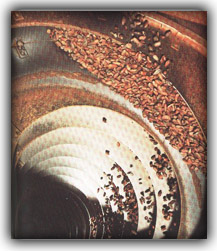At the chocolate factory, the cocoa beans
are cleaned, roasted and shelled. The roasting fills the sir with
chocolate's mouthwatering aroma. The beans are broken into larger
pieces called nibs and then these are grounded, producing rich brown liquid
or paste called "chocolate liquor” (although it has no alcoholic content).
This liquor is the main ingredient for all chocolate
| products. Some of the liquor id hardened into moulds to
form baking (bitter) chocolate but most is pressed to extract the cocoa
butter. The resulting block, once the cocoa butter has been removed,
is called "dress cake”. This is dried and sifted to make cocoa powder. |

|
These three products- chocolate liquor, cocoa
powder and cocoa butter- are combined to make all the different kinds of
chocolate.

To make milk chocolate, the chocolate liquor
is added to fluid or powdered milk sugar. If cocoa butter and sugar
only are used, with no chocolate liquor, white chocolate will result.
Cocoa butter plus chocolate liquor and sugar makes the familiar sweet (eating)
chocolate. If vegetable fat is substituted for cocoa butter, the
resulting baker's or compound chocolate cannot be legally sold as chocolate
in most countries.
 |
To make milk chocolate,
the chocolate liquor is added to fluid or powdered milk sugar. If
cocoa butter and sugar only are used, with no chocolate liquor, white chocolate
will result. Cocoa butter plus chocolate liquor and sugar makes the
familiar sweet (eating) chocolate. If vegetable fat is substituted
for cocoa butter, the resulting baker's or compound chocolate cannot be
legally sold as chocolate in most countries. The mixtures are blended,
spices and flavorings may be added, then the chocolate |
| undergoes a long stirring or "conching”
period to make it smooth and creamy. After this, it is moulded into
blocks and bars, wrapped and shipped to bakeries where it is used as an
ingredient in cakes and biscuits, or sent straight to confectioneries. |
 |
Finally the dried seeds are ready for packing
shipping. Then the manufacturer takes over. Since chocolate
seeds from various countries and from different plantations and different
trees do not all taste alike, the chocolate manufacturer will probably
blend several different types. And manufacturing methods differ from
one factory to another. Timing, temperatures, proportions of ingredients,
and processing are all extremely closely guarded secrets.
 |
Once in the factory, each step is carefully
controlled under the most sanitary conditions. First the seeds are
fumigated and stored in a clean, cool, airy location where they cannot
absorb any odors. Next they are sieved and cleaned by a machine that
removes any dried pulp, pieces of pod, etc., that may have remained.
Then they are weighed and blended according to sizes. Next they are roasted
in large rotary cylinders at a temperature of 25C to 35C for thirty minutes
to two hours, depending |
on the seeds and the manufacturer's formula. At this stage,
for the first time, they begin to develop a "chocolate” flavor and aroma.
After roasting and cooling, the seeds are shelled,
leaving the meat, which is called "nibs”. The nibs contain an average
of 50% to 54% cocoa butter, which is a natural vegetable fat. The
next step is to crush the seeds between large grinding stones or heavy
steel disks. This process, called conching, generates enough heat
to liquefy the cocoa butter, most of which is removed, leaving a thick,
dark paste which is called the chocolate "liquor.” When this liquor
is poured into molds and solidified, it is unsweetened chocolate.
If still more of the cocoa butter is removed, it is cocoa powder.
|